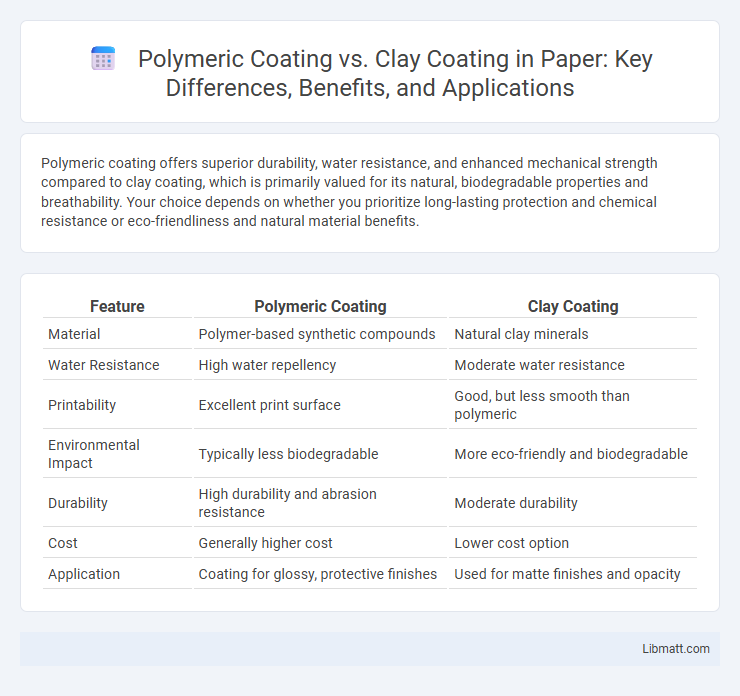Polymeric coating offers superior durability, water resistance, and enhanced mechanical strength compared to clay coating, which is primarily valued for its natural, biodegradable properties and breathability. Your choice depends on whether you prioritize long-lasting protection and chemical resistance or eco-friendliness and natural material benefits.
Table of Comparison
| Feature | Polymeric Coating | Clay Coating |
|---|---|---|
| Material | Polymer-based synthetic compounds | Natural clay minerals |
| Water Resistance | High water repellency | Moderate water resistance |
| Printability | Excellent print surface | Good, but less smooth than polymeric |
| Environmental Impact | Typically less biodegradable | More eco-friendly and biodegradable |
| Durability | High durability and abrasion resistance | Moderate durability |
| Cost | Generally higher cost | Lower cost option |
| Application | Coating for glossy, protective finishes | Used for matte finishes and opacity |
Introduction to Automotive Coatings
Polymeric coatings offer durable protection with flexibility and resistance to chemicals, abrasion, and UV damage, making them ideal for automotive exteriors. Clay coatings provide exceptional surface smoothness and contaminant removal but lack the long-term protective qualities of polymeric options. Choosing the right automotive coating ensures your vehicle maintains its appearance and withstands environmental challenges effectively.
What is Polymeric Coating?
Polymeric coating is a durable, synthetic layer applied to surfaces to enhance protection against corrosion, abrasion, and environmental damage. It consists of polymer resins that form a strong, flexible barrier, often used in automotive, industrial, and packaging applications for improved longevity and performance. Your choice between polymeric and clay coatings depends on the desired durability, surface finish, and specific functional requirements.
What is Clay Coating?
Clay coating is a natural, mineral-based surface treatment commonly used in agriculture and horticulture to protect seeds and plants by enhancing moisture retention and providing a physical barrier against pests and diseases. Unlike polymeric coatings, which use synthetic materials to form a flexible, durable layer, clay coatings rely on fine particles of bentonite or kaolin clay to create a breathable, eco-friendly film. This coating improves seed germination rates and plant health by regulating temperature and preventing fungal infections.
Application Process: Polymeric vs. Clay Coating
Polymeric coatings involve a chemical bonding process that creates a durable, long-lasting protective layer on surfaces, typically requiring precise application techniques such as spray or dip coating followed by curing. Clay coatings are applied through a physical process using clay bars to remove contaminants and smooth the surface, providing temporary protection by physically lifting impurities rather than forming a chemical bond. The polymeric application demands more preparation and controlled conditions, while clay coating is a manual, less technical process focused on surface cleanliness and immediate aesthetic improvement.
Durability Comparison
Polymeric coatings exhibit superior durability compared to clay coatings due to their enhanced resistance to abrasion, chemicals, and environmental factors like UV radiation and moisture. Clay coatings, while effective for initial surface smoothness and short-term protection, tend to wear off more quickly under harsh conditions. The long-lasting nature of polymeric coatings makes them ideal for applications requiring robust, extended protection.
Protection Capabilities: Surface & Environmental Resistance
Polymeric coatings provide superior surface protection through their flexibility and strong adhesion, effectively resisting scratches, UV radiation, and chemical contaminants on your vehicle. Clay coatings primarily offer environmental resistance by removing embedded contaminants and minor surface imperfections but lack the long-term durability of polymeric options. For maximizing protection capabilities, polymeric coatings deliver enhanced resistance against harsh weather conditions and pollutant exposure compared to clay coatings.
Gloss, Shine, and Aesthetic Impact
Polymeric coatings deliver superior gloss and shine, creating a durable, high-impact aesthetic that enhances your vehicle's paint depth and clarity. Clay coatings, while excellent for removing contaminants and smoothing surfaces, do not provide the same level of gloss or lasting shine as polymeric alternatives. For a show-stopping finish with maximum visual appeal, polymeric coating offers a more vibrant and reflective surface compared to the subtle enhancement from clay treatments.
Maintenance Requirements
Polymeric coatings typically require regular cleaning and occasional reapplication to maintain their protective properties against corrosion and wear. Clay coatings, known for their durability and self-healing abilities, demand less frequent maintenance but may need periodic polishing to restore their smooth surface and optical clarity. Choosing the appropriate coating depends on your desired balance between maintenance effort and long-term protection.
Cost Analysis: Polymeric Coating vs. Clay Coating
Polymeric coatings generally offer a lower upfront cost compared to clay coatings due to cheaper raw materials and simpler application processes. Clay coatings, while more expensive initially, provide longer-lasting durability and superior protection, potentially reducing replacement frequency and maintenance expenses over time. Your choice between polymeric and clay coatings should consider both immediate budget constraints and long-term cost-effectiveness for optimal investment.
Which Coating Is Best for Your Vehicle?
Polymeric coatings offer superior durability and hydrophobic properties, providing long-lasting protection against UV rays, chemicals, and minor scratches compared to clay coatings, which primarily serve to remove surface contaminants and smooth the paint. Clay coatings are ideal for preparing the vehicle's surface before applying sealants or ceramic coatings, while polymeric coatings form a protective barrier that enhances gloss and reduces maintenance. For long-term vehicle protection and improved aesthetic appeal, polymeric coatings are generally the better choice.
Polymeric coating vs clay coating Infographic

 libmatt.com
libmatt.com